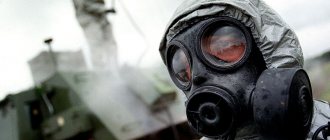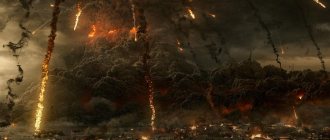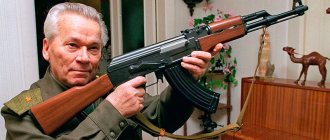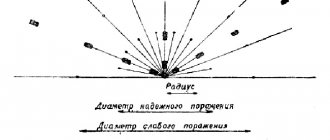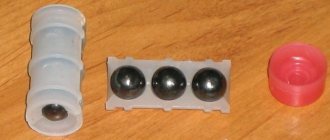New types of weapons of mass destruction
Wartime emergencies can be created by the use of weapons of mass destruction (WMD), i.e. weapons of great lethality. Existing types of weapons of mass destruction include: nuclear; chemical; bacteriological.
In addition, it is possible to use new types of weapons of mass destruction:
geophysical; radial; radiological; radio frequency; infrasound, etc.
To develop new types of weapons of mass destruction, previously unknown or unused technical principles and phenomena are used. In this case, the goal is often not so much to increase the scale of the defeat, but to obtain new opportunities for a sudden defeat of the enemy.
Geophysical weapons is a term widely used abroad, denoting a set of various means that make it possible to use the destructive forces of nature for military purposes through artificially induced changes in the physical properties and processes occurring in the atmosphere, hydrosphere and lithosphere of the Earth.
The ability to use many natural processes for destructive purposes is based on their enormous energy content. The methods of actively influencing them are quite diverse. For example:
initiation of artificial earthquakes in earthquake-prone areas, powerful tidal waves such as tsunamis, hurricanes, mountain falls, avalanches, landslides, mudflows, etc.;
the formation of drought, rainfall, hail, fog, congestion on rivers, destruction of hydraulic structures, etc.
In some countries, the possibilities of influencing the ionosphere are being studied in order to create artificial magnetic storms and auroras to disrupt radio communications and complicate radar observations over large areas.
To influence natural processes, means such as chemicals, powerful generators of electromagnetic radiation, thermal generators, etc. can be used. However, the most effective means of influencing geophysical processes is considered to be the use of nuclear weapons.
The damaging factors of geophysical weapons are the catastrophic consequences of provoked dangerous natural phenomena.
Radiological weapons are one of the possible types of weapons of mass destruction.
Its action is based on the use of radioactive warfare substances (RAS), used in the form of specially prepared powders or solutions of substances containing radioactive elements that cause an ionization effect. Ionizing radiation destroys body tissue, causing local damage or radiation sickness. The effect of BRV is comparable to the effect of radioactive substances that are formed during a nuclear explosion and contaminate the surrounding area.
The main source of FFS is waste generated during the operation of nuclear reactors or substances specially produced in nuclear reactors with different half-lives. The use of ballistic missiles can be carried out using aerial bombs, unmanned aircraft, cruise missiles, etc.
Beam weapons are a set of devices (generators), the destructive effect of which is based on the use of highly directed beams of electromagnetic energy (lasers, beam accelerators).
Combat lasers are powerful emitters of electromagnetic energy in the optical range. The damaging effect of a laser beam is achieved as a result of heating material objects to high temperatures, melting or damaging sensitive elements of equipment, etc. The impact on humans manifests itself in the form of damage to vision and thermal burns of the skin. The action of the laser beam is characterized by stealth, high accuracy, straightness of propagation and instantaneous action.
Environmental factors such as fog, rain, snow and dust significantly reduce the damaging effect of a laser beam. Therefore, the most effective use of a laser beam can be achieved in outer space to destroy ballistic missiles and artificial Earth satellites.
Accelerator weapons are a type of beam weapon. The damaging factor of such a weapon is a sharply directed beam of charged or neutral particles (electrons, protons, neutral hydrogen atoms) accelerated to high speeds. A powerful flow of energy creates mechanical shock loads on the target, intense thermal effects and causes short-wave electromagnetic (X-ray) radiation.
The targets of such weapons can be not only spacecraft or missiles, but also various types of ground weapons. There is a possibility of irradiation of large areas of the earth's surface by accelerator weapons from space with massive damage to people and animals.
Radio frequency weapons are weapons whose destructive effect is based on the use of electromagnetic radiation of ultra-high frequency (in the range up to 30 GHz) or very low frequency (less than 100 Hz). The targets of these weapons are manpower. This refers to the ability of electromagnetic radiation in the range of ultra-high and very low frequencies to cause damage to vital human organs (brain, heart, blood vessels). It can affect the psyche, disrupting the perception of the surrounding reality, causing auditory hallucinations, etc.
Infrasonic weapons are a means of mass destruction based on the use of directed radiation of powerful infrasonic vibrations with a frequency below 16 Hz. Such fluctuations can affect the central nervous system and digestive organs of a person, causing headaches and pain in the internal organs, disrupting the rhythm of breathing. Infrasound also has a psychotropic effect on humans, causing loss of self-control, feelings of fear and panic.
Rocket engines equipped with resonators and sound reflectors are used as infrasound generators. It is possible to use two sound generators with a difference frequency perceived as infrasound.
Conventional means of destruction. Classification and characteristics
The terms “ conventional means of attack ” and “ conventional weapons ” came into use after the advent of nuclear weapons, which have immeasurably higher combat properties.
Conventional weapons include all fire and strike weapons, used artillery, anti-aircraft, aviation, small arms and engineering ammunition and missiles in conventional equipment, incendiary ammunition and mixtures.
Conventional weapons can be used independently and in combination with nuclear weapons to destroy enemy personnel and equipment, as well as to destroy and destroy various objects (chemical plants, nuclear power plants, hydraulic structures, etc.).
Fragmentation, high-explosive, cumulative, concrete-piercing, incendiary and volumetric explosion ammunition
.
1). Fragmentation munitions are designed primarily to kill people. The most effective ammunition of this type are ball bombs. They are dropped from aircraft in cassettes containing from 96 to 640 bombs. Above the surface of the earth, such a cassette opens, and the bombs scatter and explode over an area of up to 250,000 m2. The lethal force of the destructive elements (metal balls d = 2-3 mm) of each bomb is maintained within a radius of up to 15 m. You can hide from ball bombs in buildings, various types of shelters, folds of terrain, etc.
2). High-explosive ammunition is intended for the destruction of industrial, residential and administrative buildings, railways and highways, destruction of equipment and people. The main damaging factor of high-explosive ammunition is the air shock wave that occurs during the explosion of the conventional explosive with which these ammunition is loaded.
Shelters and various types of shelters effectively protect against shock waves and fragments of high-explosive and fragmentation ammunition.
3). HEAT ammunition is designed to destroy armored targets. Their principle of operation is based on burning through an obstacle with a powerful jet of explosive detonation products with t0 ≈ 6000-7000 degrees and a pressure of 5000-6000 kgf/cm2. The formation of a cumulative jet is achieved due to a cumulative notch in the explosive charge. Focused detonation products are capable of burning holes in armored floors several tens of centimeters thick and causing fires.
4). Concrete-piercing ammunition is designed to destroy high-strength reinforced concrete structures and to destroy airfield runways. Typically, two charges are placed in the ammunition body - cumulative and high-explosive and two detonators. When encountering an obstacle, an instantaneous detonator is triggered, which detonates the shaped charge. With some delay (after the ammunition passes through the ceilings), the second detonator is triggered, detonating the high-explosive charge, which causes the main destruction of the object.
5). Incendiary ammunition is intended to kill people, destroy by fire buildings and structures of industrial facilities and populated areas, rolling stock and various warehouses.
The basis of incendiary ammunition is incendiary mixtures and substances. They are divided into groups:
- incendiary mixtures based on petroleum products (napalm);
- metallized incendiary mixtures (pyrogels);
- thermite and thermite compounds;
- regular or plasticized phosphorus.
Of the first group, napalm “B” is considered the most effective. In addition to petroleum products, napalm “B” includes polystyrene and salts of naphthenic and palmitic acids. In appearance, it is a gel that adheres well even to wet surfaces. When napalm “B” burns, temperatures reach 1200° C and toxic gases are released. Burning napalm is capable of penetrating through holes and cracks and causing damage to people in shelters and equipment.
Pyrogels are thickened metallized fire mixtures based on petroleum products. They contain magnesium or aluminum shavings (or powder), so they burn with flashes, developing a temperature of up to 1600 ° C. The slag formed during combustion is capable of burning through thin sheets of metal.
Thermite compounds are mechanical mixtures consisting of powdered metals (for example, aluminum) and metal oxides (for example, ferrous oxide). When burning thermite compositions, temperatures reach up to 3000° C. These compositions can burn without access to atmospheric oxygen, because When a chemical reaction occurs, oxygen is released from metal oxides.
White phosphorus spontaneously ignites in air. When burning, a temperature of 900° C develops. When burning, a large amount of white toxic smoke (phosphorus oxide) is released, which, along with burns, can cause severe injuries to people.
The basis of incendiary ammunition of various types are aviation incendiary bombs and tanks. In addition, it is possible to use incendiary weapons with barrel and rocket artillery, with the help of incendiary landmines, grenades and bullets.
The most effective protection of people from incendiary weapons is provided by protective structures.
6). Volumetric explosion ammunition. The principle of operation of such ammunition is as follows: liquid fuel (usually ultra-volatile fuel) with a high calorific value (ethylene oxide, diborane, acetic acid peroxide, propyl nitrate), placed in a special shell, during an explosion sprays out, evaporates and mixes with oxygen in the air. In this case, a spherical cloud of air-fuel mixture with a radius of about 15 m and a layer thickness of 2-3 cm is formed. The resulting mixture is detonated in several places by special detonators. In the detonation zone, a temperature of up to 2500-3000 ° C develops in a few microseconds. At the moment of explosion, a relative void is formed inside the shell from the air-fuel mixture. Something similar to an explosion of the shell of a ball with evacuated air (“vacuum bomb”) occurs.
The main damaging factor of a BW is the shock wave. In terms of their power, volumetric explosion ammunition occupies an intermediate position between nuclear and conventional (high-explosive) ammunition. Excess pressure in the shock wave front of the explosive explosive device at a distance of up to 100 m from the center of the explosion can reach 100 kPa (1 kgf/cm2).
Thus, the modern weapons considered can be used in wartime emergencies. Knowledge of these SSPs allows us to develop measures to protect people and ways to increase the sustainability of military and civilian industrial facilities.
38. Weapons of mass destruction. Classification and characteristics..
Modern means of destruction include nuclear weapons, chemical weapons, bacteriological weapons, and new types of weapons being developed.
Depending on the type of charge, weapons are divided into: atomic, thermonuclear, combined, neutron. The power of nuclear weapons is usually measured in TNT equivalent.
When a nuclear weapon explodes in millionths of a second, a colossal amount of energy is released, so in the zone of nuclear reactions the temperature rises to tens of millions of degrees, generating very strong light radiation, and the maximum pressure reaches billions of atmospheres. Such enormous pressure, affecting the environment, causes a powerful shock wave. Near the shock wave, the explosion of a nuclear weapon is accompanied by an intense flow of neutrons and gamma radiation, which is called penetrating radiation. The movement of electrons and ions in the air, which arise under the influence of ionizing radiation, leads to the formation of an electromagnetic pulse (EMP).
Neutron ammunition
. The development of nuclear weapons proceeded both along the line of increasing the power of nuclear charges and by reducing the size and weight of ammunition.
The use of different initial transuranium isotopes makes it possible to create nuclear weapons of very low power. The first representative of a new type of weapon is neutron ammunition. Neutron ammunition is small-sized, with a thermonuclear charge with a power of 3.5 to 2 kt; its main energy particle is released due to the fusion reaction of deuterium and tritium nuclei. As a result of the explosion of this ammunition, 70% of the total explosion energy is released in the form of penetrating radiation (a flux of neutrons and gamma rays).
Chemical weapon
Its action is based on the use of toxic chemicals and toxins that affect the human or animal body, as well as phytotoxicants to attack various types of plants. According to their tactical purpose, agents are divided into: lethal, temporary, irritant.
Toxins are chemical substances of protein nature of plant, animal or microbial origin. They have high toxicity and the ability to have an impressive effect on people and animals. These include: botulinum toxin, which is the strongest lethal poison known in our time. Death occurs within 1 hour from paralysis of the heart muscle and respiratory muscles.
Biological weapons
The impressive effect of BW is based on the use of the pathogenic properties of certain microbes and the toxic products of their vital activity. Pathological microorganisms – causative agents of infectious diseases – are used. Depending on the size, structure and biological properties they are divided into:
— bacteria (plague, anthrax, sniffles, etc.);
- Rickettsia - cells, rods (typhus);
- fungi - microorganisms of plant origin;
— viruses are a large group of biological organisms that do not have
Cellular structure capable of developing and multiplying only in living cells (smallpox, tropical fever, foot and mouth disease, etc.).
New types of weapons
The most promising are:
Beam weapon
- this is a set of devices (generators), the impressive action of which is based on the use of highly directed beams of electromagnetic energy or a concentrated beam of elementary particles accelerated to high speeds. One type is based on the use of lasers, the other is a beam weapon.
Radio frequency weapons
is a weapon whose impressive effect is based on the use of electromagnetic radiation of ultra-high frequencies (UHF) or ultra-low frequencies (ELF). An impressive effect - damage, disruption of vital functions, organs and systems of a person, such as the brain, heart, circulatory system, central nervous system.
Radiological weapons
– the action of which is based on the use of radioactive warfare substances (RAS), as well as waste generated during the operation of nuclear reactors.
Geophysical weapons
- a set of different means that allow the use for military purposes of the destructive forces of lifeless nature by artificially initiating them: such as hurricanes, artificial earthquakes, mountain falls, avalanches, shifts, mudflows, artificial magnetic storms, droughts, destruction of the ozone layer, etc. d.
Table
| Conventional means of destruction | ||
| Precision weapons | By purpose | By type |
| Reconnaissance strike complexes | Fragmentation | Missiles |
| High explosive | Missile and torpedo warheads | |
| Cumulative | Ammunition for small arms | |
| Guided bombs | Concrete | Grenades |
| Incendiary | Aviation and depth charges | |
| volumetric explosion | Engineering and naval mines | |
| Demolition charges | ||
Fragmentation
The main feature is the presence of a huge number of ready-made or semi-ready lethal elements designed to exterminate enemy soldiers. The fragments can scatter over a radius of up to three hundred meters. Of these, cluster ball bombs and high-explosive ammunition are of greatest interest. In a ball bomb, the striking element is pieces of metal and plastic of various diameters. The usual delivery method is an airplane that drops a batch of these bombs in cassettes of varying quantities. Can cover an area of over two hundred thousand square meters. m.
A separate type is high-explosive ammunition, the blast wave and fragments of which destroy large ground objects.
Vacuum bomb
This terrible weapon also belongs to modern conventional weapons. It is considered the most dangerous invention of mankind after nuclear weapons, but its impact on the environment is kept to a minimum. Despite all the destructiveness for all living things, it leaves buildings and equipment practically undamaged, which makes it very promising for use in conflicts.
Principle of operation. A container is dropped from an airplane using a parachute, in which a detonator is launched at a certain altitude, destroying the bomb shell. An aerosol cloud is immediately sprayed over the surrounding area and increases sharply. Mixing with the air and as if attached to it, it penetrates into the most inaccessible places (from open windows to bunkers). Even in the mountains, in caves, you can’t hide from him. All this time the cloud is increasing in size. When the required concentration of the substance in the air is reached, the second detonator is launched. After this, all the oxygen in the resulting mixture of air and ejected substance is destroyed, which leads to the formation of a vacuum. Not a single earthly creature is capable of surviving in such conditions.
It's all about the low pressure in this artificially created lack of oxygen. Human vessels are not able to withstand such overloads. Another important advantage is the supersonic shock wave and incredibly high temperature. Taken together, all these factors leave virtually no chance for enemy manpower.
Precision weapons
A striking example is cruise missiles, or, as they were originally called, aircraft-projectiles. The first developments have been carried out since the first conflicts of the early twentieth century. Refers to precision weapons as an independent type of offensive strategic weapons. Capable of maneuvering in various terrain conditions at low altitudes. This makes it difficult to detect. One of the main disadvantages is its price and weak charging power. With current trends in scientific and technological progress, the importance of nuclear-free cruise missiles will increase. For the dynamic optimal development of this area, a Global Space Navigation System is needed. At the moment, the USA and Russia have it. The European Union has also come close to completing the development of this program at home.
Incendiary
This is a whole complex of means using incendiary substances. It is no coincidence that Americans consider it a weapon with a huge psychological effect. This type of weapon is divided into incendiary mixtures, metallized incendiary mixtures and thermite compositions.
Incendiary mixture. The famous fire mixture, better known as napalm. The composition is based on gasoline with the addition of thickener powder. It has two convenient properties when used: it ignites well and adheres perfectly to any surface. It even burns in water. The temperature it creates is approximately 1200 degrees.
Pyrogel. A petroleum product to which powdered magnesium, heavy oils, and liquid asphalt are added.
White phosphorus. Used as a napalm igniter.
Man-made climate phenomena as weapons
I am often told that human society today is in deep decadence.
Many are amazed at how education, morality, and even the sense of beauty are deteriorating. The classic “yes, there were people in our time, not like the current tribe...” I cannot judge humanity. But some of the questions that readers raise really drive us into a deep stupor. One of these questions concerns the existence of climate weapons as such. Do such weapons exist at all, or is this just a common invention of journalists to raise the ratings of their own publication? Agree, the question is quite unexpected, especially considering the “Convention on the Prohibition of Military or Any Other Hostile Use of Means of Impact on the Natural Environment” adopted back in December 1976 by UN General Assembly Resolution 31/72.
However, after some thought, I realized that the question really requires clarification. And it arose from a simple misunderstanding of the very term “climate weapon”.
Climate weapons are one of the types of weapons of mass destruction
The damaging factor of climate weapons are various natural or climatic phenomena created artificially.
Accordingly, such weapons will hit not only enemy troops, but all living things in general. Classic weapon of mass destruction! Any war is fought in certain climatic conditions. And the generals of the losing army always cite climate or terrain as one of the main reasons for defeat. Remember “General Moroz”, who defeated the Germans near Moscow in 1941? And what about the Russian autumn thaw that stopped the offensive?
The dream of every general and soldier is something that would destroy the enemy army without his participation. Imagine the picture: a huge army is attacking your positions - and suddenly a hurricane or tropical downpour! Or even wider. A huge army is concentrated on your borders. Infrastructure has been created, fuel has been supplied, ammunition and food warehouses have been prepared. And suddenly - an earthquake! And the enemy army is completely incapable of combat.
It’s not for nothing that I called the events described above dreams. Nature, or more precisely, our knowledge about nature, has been and remains terra incognita for humanity. We have not learned to understand its laws and make natural phenomena “work” for us and will not learn for a long time. It is possible to cause an earthquake or rainstorm today. But these natural disasters can hit your own army no less than the enemy’s army.
Climate weapons have already been used in modern wars
If weapons exist, then, given the number of wars and military conflicts in the modern world, there must be cases of the use of such weapons or their elements.
And there is a country for which the use of weapons of mass destruction poses neither moral nor political problems. Test an atomic bomb on real cities and civilians? No problem! Test climate weapons? No problem. Many people know that during the Vietnam War, the Ho Chi Minh trail caused a lot of trouble for the American army. This is a route over 20 thousand km long, along which the supply of Vietnamese troops from the Democratic Republic of Vietnam to South Vietnam took place. Despite the fact that this “road”, which includes not only land routes, but also waterways, had such a length, the Americans were unable to destroy it.
Bombings, special units of Tunnel Rats, the use of chemicals to destroy vegetation (Agent Orange) and other American tricks... But the Ho Chi Minh Trail operated throughout the war. And only the use of climate weapons could disable this path, and even then for a short time.
The fact is that American scientists have proposed using special substances that increase rainfall during the rainy season from March to November. The spraying was carried out by airplanes. The first use of climate weapons dates back to March 20, 1967. The Americans used rainstorms to wash out the roads included in the “trail” in the period from March 20, 1967 to July 5, 1972.
Climate weapons today
It is clear that no one will advertise the development of climate weapons.
This is connected not so much with the convention signed by the United States and Russia, but with the fact that such technologies, if invented, will become truly revolutionary, capable of changing the balance of power on the planet. Possession of such weapons will allow one to blackmail any country and thus achieve any goals. At the same time, in recent decades, the governments of a number of rich countries have become very concerned about the environmental situation on Earth. Many laboratories, institutes, and research centers have been created that study literally everything. Starting from the bowels of the planet and ending with deep space. And in each such laboratory there is a closed sector.
The American HAARP complex, which is located in Alaska, and the Sura facility in Russia (near Nizhny Novgorod) should be mentioned. Let me make a reservation right away that no one officially calls these objects elements of weapons for climate war. And what was leaked to the press was more likely in the realm of journalists’ guesses and hypotheses. The secrecy of the complexes is complete.
Many experts call the American HAARP complex the first such object in the world. The complex began to be built not so long ago, in the early 90s of the last century. The Russian complex appeared as a response to the American one. This point of view is not true. The Americans built the largest complex. Not the first in the world, but the largest. The area occupied by the antennas of the American complex is 13 hectares!
Such complexes began to be built back in the 60s! And quite a lot of facilities were built in the USSR, the USA, Europe, and even South America. The official version of the appearance of such objects is the study of the Earth's ionosphere. More precisely, electromagnetism in high layers of the atmosphere is being studied. The reason for this interest is also known. The processes occurring there greatly influence the formation of the climate on Earth.
Why do many experts call the HAARP and Sura complexes military targets and even “climate weapons”? During the construction of the American complex, funding was provided not so much by scientists as by the US Air Force and Navy, as well as the Department of Advanced Research Projects (DARPA). And the majority of military scientists work there now.
What I wrote above are facts. And now about what is not known for certain and, in my opinion, relates more to speculation and unscientific fiction of journalists and (even!) scientists.
So, the complexes can change the weather in individual regions and countries. It would be interesting to know from the author of this gem how complexes determine the borders of countries? And how does “changed weather” not cross these boundaries? Who works as a “border guard” for the weather?
The next “fact” that is terrible for humanity, just made up, is the ability to cause earthquakes in some parts of the planet. At the present stage of development of science, we even have an understanding of the nature of earthquakes at the level of guesses and hypotheses, so how can we cause an earthquake locally? It seems to me that the authors confused an earthquake and the shaking of the earth from the use, for example, of nuclear weapons for underground explosions.
Some theories of fairly well-known American scientists about the possibility of causing hurricanes and directing them to certain points on the Earth look no less stupid. By the way, after every hurricane in the United States, and there this phenomenon is quite common, such opinions appear precisely among scientists.
I will only mention the delusional possibilities of the complexes. I think that readers will be smart enough to understand their delusion on their own. So, with the help of complexes, the military has the ability to control people’s consciousness! Using the complexes, you can shoot down satellites and warheads flying in space. Well, and similar horror stories.
Weapons that exist, but are not there
Does humanity have a climate weapon?
The answer to this question can be unequivocal. Yes, there is such a weapon! Does humanity have climate weapons as another type of weapon of mass destruction? No! These are the inventions of idle journalists and fantastic stories about the future. We have learned to disperse the clouds. We learned how to collect steam into clouds. We learned a lot today. However, at the moment, man has only come closer to understanding the essence of some, I emphasize, some natural phenomena. We, it seems to me, have only just reached the understanding that man is not the king of nature, but just a part of the surrounding world.
We have come to understand that any nasty thing created by humanity, be it climate, biological or other weapons, will lead to consequences that cannot be predicted at the planetary level. Will lead to consequences that can cause the death of humans as a biological species! COVID-19 has shown us how defenseless we are, how vulnerable humanity as a whole is.
Administration of the municipal district of Armavir
10/12/2018 2:44:12 pm
A person who knows about the features of a particular weapon, how to use it and its damaging effect will be able to try to defend against it or prepare in a timely manner for protection from the damaging effect of a weapon.
Today, nuclear weapons are still considered by the country's leadership as one of the elements of great power and maintaining strategic stability. About half of the funds of the state defense order are spent on the needs of the strategic missile forces. Significant funds are being allocated to the production of a new “super weapon” that, according to military leaders, can overcome any missile defense system. The possibility of using tactical nuclear weapons, including in local conflicts, was widely discussed. Fundamental security documents provide for the use of nuclear weapons in the event that a threat to the existence of Russia as a state arises and conventional means prove ineffective.
Nuclear weapon
- explosive weapons of mass destruction based on the use of intranuclear energy. Nuclear weapons, one of the most destructive weapons of war, are among the main types of weapons of mass destruction. It includes various nuclear weapons (warheads of missiles and torpedoes, aircraft and depth charges, artillery shells and mines equipped with nuclear chargers), means of controlling them and means of delivering them to the target (carriers). The destructive effect of nuclear weapons is based on the energy released during nuclear explosions.
Damaging factors of a nuclear explosion
- shock wave, light radiation, penetrating radiation, radioactive contamination and electromagnetic pulse.
Shock wave
- the main damaging factor of a nuclear explosion, since most of the destruction and damage to structures, buildings, as well as injuries to people are caused by its impact.
Light radiation
is a stream of radiant energy that includes ultraviolet, visible and infrared rays. Its source is a luminous area formed by hot explosion products and hot air. Penetrating radiation is a stream of gamma rays and neutrons. Its sources are nuclear fission and fusion reactions occurring in the ammunition at the moment of explosion, as well as the radioactive decay of fission fragments (products) in the explosion cloud.
The time of action of penetrating radiation on ground objects is 15-25 s.
Radioactive contamination
. Its main sources are fission products of a nuclear charge and radioactive isotopes formed as a result of the influence of neutrons on the materials from which nuclear weapons are made, and on some elements that make up the soil in the area of the explosion. It is most dangerous in the first hours after radioactive fallout.
Electromagnetic pulse
is a short-term electromagnetic field that occurs during the explosion of a nuclear weapon as a result of the interaction of gamma rays and neutrons emitted with the atoms of the environment. The consequence of its impact may be the failure of individual elements of radio-electronic and electrical equipment. People can only be harmed if they come into contact with wire lines at the time of the explosion.
Chemical weapon
is a weapon of mass destruction, the action of which is based on the toxic properties of certain chemicals. It includes chemical warfare agents and means of their use. Toxic substances (TS) are chemical compounds that can infect people and animals over large areas, penetrate various structures, and contaminate terrain and water bodies. They are used to equip missiles, aircraft bombs, artillery shells and mines, chemical landmines, as well as airborne discharge devices (VAP). OM is used in a drop-liquid state, in the form of steam and aerosol. They can penetrate the human body and infect it through the respiratory organs, digestive organs, skin and eyes.
Based on their effect on the human body, toxic substances are divided into nerve agents, vesicants, asphyxiants, generally toxic substances, irritants and psychochemical agents.
Toxic substances
nerve agents (Vi-X, sarin) affect the nervous system when acting on the body through the respiratory system, when penetrating in a vaporous and droplet-liquid state through the skin, as well as when entering the gastrointestinal tract along with food and water. Toxic substances with blister action (mustard gas) have a multifaceted damaging effect. In a droplet-liquid and vapor state, they affect the skin and eyes, when inhaling vapors - the respiratory tract and lungs, and when ingested with food and water - the digestive organs. Asphyxiating toxic substances (phosgene) affect the body through the respiratory system.
Generally toxic toxic substances (hydrocyanic acid and cyanogen chloride) affect a person only when he inhales air contaminated with their vapors (they do not act through the skin). Irritating toxic substances (CS, adamsite, etc.) cause acute burning and pain in the mouth , throat and eyes, severe lacrimation, cough, difficulty breathing. Toxic substances of psychochemical action (Bi-Z) specifically act on the central nervous system and cause psychological (hallucinations, fear, depression) or physical (blindness, deafness) disorders.
According to their tactical purpose, toxic substances are divided into groups depending on the nature of the damaging effect: lethal, temporarily incapacitating, and irritating.
Lethal toxic substances are designed to fatally defeat an enemy or incapacitate him for a long period of time. Such chemical agents include sarin, soman, Vi-X, mustard gas, hydrocyanic acid, cyanogen chloride, and phosgene. Toxic substances that temporarily incapacitate include psychochemical substances that act on the nervous system of people and cause temporary mental disorders in them (Bi-Z). Irritating toxic substances (police agents) affect the sensitive nerve endings of the mucous membranes of the upper respiratory tract and act on the eyes. These include chloroacetophenone, adamsite, CC, CC
Bacteriological weapons
- These are special ammunition and combat devices equipped with biological agents. This weapon is intended for mass destruction of manpower, farm animals and crops. Its damaging effect is based on the use of the pathogenic properties of microbes - pathogens of diseases in humans, animals and agricultural plants.
Pathogenic microbes
is a large group of tiny living creatures that can cause various infectious diseases. Depending on their biological characteristics, pathogenic microbes are divided into bacteria, viruses, rickettsia and fungi.
The class of bacteria includes the causative agents of plague, cholera, anthrax, and glanders. Viruses
cause smallpox and yellow fever
.
Rickettsiae are the causative agents of typhus and Rocky Mountain spotted fever.
Serious diseases
(blastomycosis, histoplasmosis, etc.) are caused by fungi.
Conventional weapons consist of all fire and strike weapons
, using artillery, anti-aircraft, aviation, small arms and engineering ammunition and missiles in conventional ammunition (fragmentation, high-explosive, cumulative, concrete-piercing, volumetric explosion), as well as incendiary ammunition and fire mixtures.
Fragmentation ammunition
are intended primarily for hitting people with lethal elements (balls, needles) and fragments.
High explosive ammunition
designed to destroy large ground objects (industrial and administrative buildings, railway junctions, etc.) with a shock wave and fragments.
Cumulative ammunition
designed to destroy armored targets. The principle of their operation is based on burning a barrier several tens of centimeters thick with a powerful jet of high-density gases with a temperature of 6000-7000 ° C. Concrete-piercing ammunition is designed to destroy airfield runways and other objects with a concrete surface.
Volumetric explosion ammunition
designed to destroy people, buildings, structures and equipment with an air shock wave and fire.
Incendiary ammunition
. Their damaging effect on people, equipment and other objects is based on the direct impact of high temperatures. This type of weapon includes incendiary substances and means of their combat use. Incendiary substances are divided into three main groups: compositions based on petroleum products; metallized incendiary mixtures; termites and termite compounds. A special group of incendiary substances consists of ordinary and plasticized phosphorus, alkali metals, as well as mixtures that ignite spontaneously in air.
A person who knows about the characteristics of a particular weapon, the methods of its use and its damaging effect will be able to try to protect himself from it or prepare in a timely manner for protection from the damaging effect of the weapon.
Cumulative
Modern conventional weapons include ammunition capable of destroying armored targets using a directed jet of high-temperature gases. Detonation products are focused, burning holes in metal that has the properties of armor of different thicknesses, so their use is also advisable for causing fires. As protection, screens made of different materials are used, located at some distance from the main structure. The energy of the jet used to burn through such a screen practically does not damage the object that has such protection.




